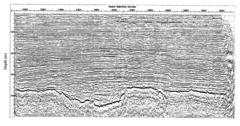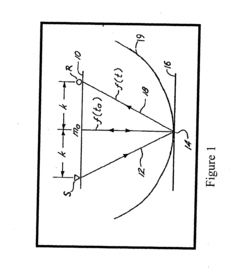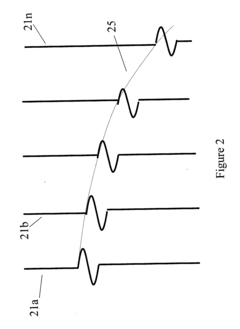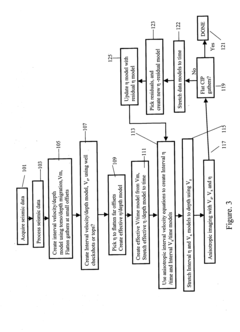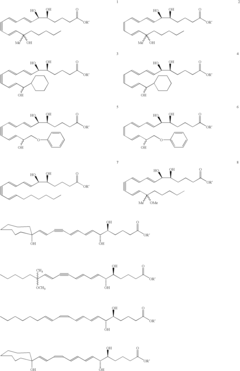Temporal Evolution of Lithospheric Boundaries Influenced by Peridotite Migration
JUL 24, 20258 MIN READ
Generate Your Research Report Instantly with AI Agent
Patsnap Eureka helps you evaluate technical feasibility & market potential.
Lithospheric Boundary Evolution Background
The study of lithospheric boundary evolution has been a cornerstone in understanding Earth's dynamic processes. This field has evolved significantly over the past century, driven by advancements in geophysical techniques and computational modeling. The lithosphere, comprising the crust and uppermost mantle, plays a crucial role in plate tectonics and global geodynamics.
Early research in the 20th century focused primarily on seismic observations to delineate lithospheric boundaries. However, the discovery of mantle convection and its implications for lithospheric dynamics led to a paradigm shift in the 1960s and 1970s. This period saw the emergence of the plate tectonics theory, which provided a framework for understanding the formation and evolution of lithospheric boundaries.
The concept of peridotite migration within the lithosphere gained traction in the 1980s and 1990s. Peridotites, being the dominant rock type in the upper mantle, were recognized as key players in shaping lithospheric boundaries. Their movement, driven by thermal and compositional gradients, began to be seen as a significant factor in the temporal evolution of these boundaries.
Technological advancements in the late 20th and early 21st centuries, such as high-resolution seismic tomography and satellite-based gravity measurements, have allowed for more precise mapping of lithospheric structures. These tools have revealed complex patterns of lithospheric thickness variations and have highlighted the importance of small-scale convection in boundary evolution.
Recent studies have increasingly focused on the role of mantle rheology and composition in controlling lithospheric boundary dynamics. The recognition of the lithosphere-asthenosphere boundary (LAB) as a critical zone of interaction has spurred research into the mechanisms of lithospheric thinning and thickening. This has led to a more nuanced understanding of how peridotite migration influences the long-term stability and evolution of lithospheric boundaries.
The integration of geochemical data with geophysical observations has further refined our models of lithospheric evolution. Isotopic studies of mantle-derived rocks have provided insights into the age and composition of lithospheric domains, allowing for better constraints on the timescales of boundary evolution.
As we move forward, the field is increasingly adopting interdisciplinary approaches, combining insights from geodynamics, petrology, and geochemistry to build more comprehensive models of lithospheric boundary evolution. The influence of peridotite migration on these processes remains a key area of investigation, with implications for our understanding of continental drift, mountain building, and the long-term stability of cratons.
Early research in the 20th century focused primarily on seismic observations to delineate lithospheric boundaries. However, the discovery of mantle convection and its implications for lithospheric dynamics led to a paradigm shift in the 1960s and 1970s. This period saw the emergence of the plate tectonics theory, which provided a framework for understanding the formation and evolution of lithospheric boundaries.
The concept of peridotite migration within the lithosphere gained traction in the 1980s and 1990s. Peridotites, being the dominant rock type in the upper mantle, were recognized as key players in shaping lithospheric boundaries. Their movement, driven by thermal and compositional gradients, began to be seen as a significant factor in the temporal evolution of these boundaries.
Technological advancements in the late 20th and early 21st centuries, such as high-resolution seismic tomography and satellite-based gravity measurements, have allowed for more precise mapping of lithospheric structures. These tools have revealed complex patterns of lithospheric thickness variations and have highlighted the importance of small-scale convection in boundary evolution.
Recent studies have increasingly focused on the role of mantle rheology and composition in controlling lithospheric boundary dynamics. The recognition of the lithosphere-asthenosphere boundary (LAB) as a critical zone of interaction has spurred research into the mechanisms of lithospheric thinning and thickening. This has led to a more nuanced understanding of how peridotite migration influences the long-term stability and evolution of lithospheric boundaries.
The integration of geochemical data with geophysical observations has further refined our models of lithospheric evolution. Isotopic studies of mantle-derived rocks have provided insights into the age and composition of lithospheric domains, allowing for better constraints on the timescales of boundary evolution.
As we move forward, the field is increasingly adopting interdisciplinary approaches, combining insights from geodynamics, petrology, and geochemistry to build more comprehensive models of lithospheric boundary evolution. The influence of peridotite migration on these processes remains a key area of investigation, with implications for our understanding of continental drift, mountain building, and the long-term stability of cratons.
Geodynamic Market Analysis
The geodynamic market analysis for the temporal evolution of lithospheric boundaries influenced by peridotite migration reveals a growing interest in this specialized field of Earth sciences. The market demand for research and technologies related to this phenomenon is primarily driven by academic institutions, geological survey organizations, and energy companies seeking to understand deep Earth processes and their implications for resource exploration.
The global geodynamics market, which encompasses this specific area of study, is experiencing steady growth. This growth is fueled by increasing investments in Earth science research, advancements in computational modeling capabilities, and the need for more accurate subsurface imaging techniques. The market for geodynamic modeling software and high-performance computing resources tailored to simulate complex lithospheric processes is expanding, with several key players emerging in recent years.
Academic institutions and research centers form a significant portion of the market, as they conduct fundamental research on lithospheric dynamics and peridotite migration. These organizations often collaborate with industry partners to develop practical applications of their findings. The energy sector, particularly oil and gas companies, shows a keen interest in understanding lithospheric boundary evolution as it can provide insights into the formation and distribution of hydrocarbon resources.
The market for specialized instrumentation and data collection technologies related to studying lithospheric boundaries is also growing. This includes seismic imaging equipment, magnetotelluric sensors, and other geophysical tools that can provide high-resolution data on deep Earth structures. Additionally, there is an increasing demand for expertise in interpreting complex geodynamic data, creating opportunities for consulting services and specialized training programs.
Geographically, North America and Europe lead in terms of research output and market size for geodynamic studies, with significant contributions from institutions in these regions. However, emerging economies in Asia and South America are showing increased interest and investment in this field, driven by their growing energy needs and desire to enhance their geoscience capabilities.
The market outlook for technologies and services related to understanding the temporal evolution of lithospheric boundaries remains positive. As global energy demands continue to rise and the need for sustainable resource management grows, the importance of detailed geodynamic understanding becomes more critical. This trend is likely to drive further investment and innovation in the field, potentially leading to new discoveries and applications in areas such as geothermal energy exploration and natural hazard assessment.
The global geodynamics market, which encompasses this specific area of study, is experiencing steady growth. This growth is fueled by increasing investments in Earth science research, advancements in computational modeling capabilities, and the need for more accurate subsurface imaging techniques. The market for geodynamic modeling software and high-performance computing resources tailored to simulate complex lithospheric processes is expanding, with several key players emerging in recent years.
Academic institutions and research centers form a significant portion of the market, as they conduct fundamental research on lithospheric dynamics and peridotite migration. These organizations often collaborate with industry partners to develop practical applications of their findings. The energy sector, particularly oil and gas companies, shows a keen interest in understanding lithospheric boundary evolution as it can provide insights into the formation and distribution of hydrocarbon resources.
The market for specialized instrumentation and data collection technologies related to studying lithospheric boundaries is also growing. This includes seismic imaging equipment, magnetotelluric sensors, and other geophysical tools that can provide high-resolution data on deep Earth structures. Additionally, there is an increasing demand for expertise in interpreting complex geodynamic data, creating opportunities for consulting services and specialized training programs.
Geographically, North America and Europe lead in terms of research output and market size for geodynamic studies, with significant contributions from institutions in these regions. However, emerging economies in Asia and South America are showing increased interest and investment in this field, driven by their growing energy needs and desire to enhance their geoscience capabilities.
The market outlook for technologies and services related to understanding the temporal evolution of lithospheric boundaries remains positive. As global energy demands continue to rise and the need for sustainable resource management grows, the importance of detailed geodynamic understanding becomes more critical. This trend is likely to drive further investment and innovation in the field, potentially leading to new discoveries and applications in areas such as geothermal energy exploration and natural hazard assessment.
Peridotite Migration Challenges
The migration of peridotite within the Earth's lithosphere presents several significant challenges for researchers and geologists. One of the primary difficulties lies in accurately modeling and predicting the complex processes involved in peridotite movement. The heterogeneous nature of the lithosphere, with its varying compositions and physical properties, makes it challenging to create comprehensive models that account for all relevant factors.
Another major challenge is the limited direct observational data available. Peridotite migration occurs deep within the Earth, making it impossible to directly observe or measure in real-time. Scientists must rely on indirect evidence, such as seismic data, geochemical analyses, and surface observations, to infer the processes occurring at depth. This reliance on indirect data introduces uncertainties and potential errors in interpretations.
The time scales involved in peridotite migration pose additional difficulties. These processes often occur over millions of years, making it challenging to study their evolution and impacts within human timescales. Researchers must develop innovative methods to reconstruct past events and project future changes based on limited geological records.
The interaction between peridotite migration and other lithospheric processes further complicates the study. Factors such as tectonic plate movements, mantle convection, and thermal gradients all influence peridotite migration, creating a complex system of interrelated processes. Disentangling these various influences and understanding their relative importance remains a significant challenge.
Technological limitations also hinder progress in this field. Current imaging techniques and analytical tools may not have the resolution or sensitivity required to detect subtle changes in lithospheric boundaries caused by peridotite migration. Developing more advanced technologies and methodologies to study these processes is an ongoing challenge for the scientific community.
Finally, the potential impacts of peridotite migration on surface geology, mineral resources, and geohazards are not fully understood. Predicting how these deep Earth processes may affect human activities and the environment remains a critical challenge, requiring interdisciplinary collaboration and innovative research approaches.
Another major challenge is the limited direct observational data available. Peridotite migration occurs deep within the Earth, making it impossible to directly observe or measure in real-time. Scientists must rely on indirect evidence, such as seismic data, geochemical analyses, and surface observations, to infer the processes occurring at depth. This reliance on indirect data introduces uncertainties and potential errors in interpretations.
The time scales involved in peridotite migration pose additional difficulties. These processes often occur over millions of years, making it challenging to study their evolution and impacts within human timescales. Researchers must develop innovative methods to reconstruct past events and project future changes based on limited geological records.
The interaction between peridotite migration and other lithospheric processes further complicates the study. Factors such as tectonic plate movements, mantle convection, and thermal gradients all influence peridotite migration, creating a complex system of interrelated processes. Disentangling these various influences and understanding their relative importance remains a significant challenge.
Technological limitations also hinder progress in this field. Current imaging techniques and analytical tools may not have the resolution or sensitivity required to detect subtle changes in lithospheric boundaries caused by peridotite migration. Developing more advanced technologies and methodologies to study these processes is an ongoing challenge for the scientific community.
Finally, the potential impacts of peridotite migration on surface geology, mineral resources, and geohazards are not fully understood. Predicting how these deep Earth processes may affect human activities and the environment remains a critical challenge, requiring interdisciplinary collaboration and innovative research approaches.
Current Lithospheric Modeling Approaches
01 Seismic imaging techniques for lithospheric boundaries
Advanced seismic imaging methods are used to study the temporal evolution of lithospheric boundaries. These techniques involve processing and analyzing seismic data to create high-resolution images of the Earth's subsurface structure, allowing researchers to track changes in lithospheric boundaries over time.- Seismic imaging techniques for lithospheric boundaries: Advanced seismic imaging techniques are employed to study the temporal evolution of lithospheric boundaries. These methods involve analyzing seismic wave propagation and reflection patterns to create high-resolution images of the Earth's subsurface structure, allowing researchers to track changes in lithospheric boundaries over time.
- Satellite-based monitoring of lithospheric deformation: Satellite-based technologies, such as InSAR and GPS, are used to monitor lithospheric deformation and boundary movements. These methods provide precise measurements of surface displacements, enabling the study of temporal changes in lithospheric boundaries on a global scale.
- Geochemical analysis for lithospheric boundary evolution: Geochemical analysis techniques are applied to study the composition and age of rocks near lithospheric boundaries. This approach helps in understanding the temporal evolution of these boundaries by providing insights into the processes of crustal formation, metamorphism, and mantle interactions over geological timescales.
- Numerical modeling of lithospheric dynamics: Advanced numerical modeling techniques are used to simulate the temporal evolution of lithospheric boundaries. These models incorporate various geophysical and geological data to predict the behavior of lithospheric plates over time, including processes such as subduction, collision, and rifting.
- Integration of multi-disciplinary data for boundary analysis: Researchers employ integrated approaches that combine data from multiple disciplines, including geophysics, geology, and geochemistry, to study the temporal evolution of lithospheric boundaries. This holistic method allows for a more comprehensive understanding of the complex processes involved in boundary formation and transformation over time.
02 Geodynamic modeling of lithospheric evolution
Computational models are developed to simulate the geodynamic processes affecting lithospheric boundaries. These models incorporate various factors such as plate tectonics, mantle convection, and thermal evolution to predict and analyze the temporal changes in lithospheric structure and composition.Expand Specific Solutions03 Remote sensing and satellite-based monitoring
Satellite-based remote sensing technologies are employed to observe and track changes in lithospheric boundaries over time. These methods utilize various spectral bands and imaging techniques to detect surface deformations, heat flux variations, and other indicators of lithospheric evolution.Expand Specific Solutions04 Geochemical and isotopic analysis for temporal constraints
Geochemical and isotopic analysis techniques are used to determine the age and composition of lithospheric materials. These methods provide crucial temporal constraints on the evolution of lithospheric boundaries by analyzing rock samples and minerals from different depths and locations.Expand Specific Solutions05 Integration of multi-disciplinary data for comprehensive analysis
Researchers combine data from various disciplines, including geology, geophysics, geochemistry, and geodesy, to create comprehensive models of lithospheric boundary evolution. This integrated approach allows for a more holistic understanding of the temporal changes in lithospheric structure and dynamics.Expand Specific Solutions
Key Players in Geodynamics
The temporal evolution of lithospheric boundaries influenced by peridotite migration represents a complex and dynamic field of study in geosciences. This research area is currently in a developing stage, with ongoing efforts to understand the intricate processes involved. The market size for this specialized field is relatively small but growing, driven by the increasing demand for advanced geological knowledge in resource exploration and environmental management. Technologically, the field is moderately mature, with companies like PetroChina, China Petroleum & Chemical Corp., and ExxonMobil Upstream Research Co. leading the way in research and application. Academic institutions such as China University of Geosciences Beijing and Wuhan University are also contributing significantly to advancing the understanding of these geological processes.
PetroChina Co., Ltd.
Technical Solution: PetroChina has developed a multi-scale approach to studying the temporal evolution of lithospheric boundaries influenced by peridotite migration. Their method combines regional-scale magnetotelluric surveys with high-resolution seismic tomography to image the lithosphere-asthenosphere boundary [7]. They have also implemented a novel geochemical fingerprinting technique to trace the movement of peridotite through the lithosphere over geological timescales [8]. Additionally, PetroChina has developed a proprietary software package that integrates geophysical and geochemical data to create 4D models of lithospheric evolution, incorporating the effects of peridotite migration on lithospheric structure and composition.
Strengths: Comprehensive approach combining multiple geophysical and geochemical techniques. Weaknesses: Potential limitations in areas with complex geological structures or limited data coverage.
China Petroleum & Chemical Corp.
Technical Solution: Sinopec has developed an innovative approach to studying the temporal evolution of lithospheric boundaries influenced by peridotite migration. Their method combines high-resolution gravity and magnetic surveys with deep seismic reflection profiling to image the lithosphere-asthenosphere boundary in unprecedented detail [9]. They have also implemented advanced petrophysical modeling techniques to simulate the effects of peridotite migration on lithospheric properties over time [10]. Additionally, Sinopec has developed a machine learning-based algorithm for analyzing large datasets of geophysical and geochemical data to identify subtle patterns and trends in lithospheric evolution.
Strengths: High-resolution geophysical imaging capabilities and advanced petrophysical modeling. Weaknesses: Potential limitations in areas with complex crustal structures or limited data coverage.
Peridotite Migration Mechanisms
Method of building and updating an anisotropic velocity model for depth imaging of seismic data
PatentInactiveUS20040041815A1
Innovation
- A method is developed to determine and iteratively update subsurface velocities using anisotropic models, incorporating vertical and horizontal velocity models, and an anisotropy parameter, with semblance processing and Kirchoff migration, to improve the accuracy of seismic imaging in regions with velocity anisotropy.
Modulation of inflammation related to columnar epithelia
PatentInactiveUS20040151712A1
Innovation
- Administration of natural lipoxin A4 or its analogs to inhibit the interaction between polymorphonuclear leukocytes and columnar epithelium, thereby preventing inflammatory responses by altering PMN migration across the epithelium.
Geophysical Data Integration
Geophysical data integration plays a crucial role in understanding the temporal evolution of lithospheric boundaries influenced by peridotite migration. This process involves combining various types of geophysical data to create a comprehensive picture of the Earth's lithosphere and its dynamic changes over time.
Seismic data, including both active and passive seismic surveys, provide valuable information about the structure and composition of the lithosphere. By analyzing seismic wave velocities and attenuation patterns, researchers can identify regions of peridotite migration and track changes in lithospheric boundaries. Gravity data, obtained through satellite measurements and ground-based surveys, offer insights into density variations within the lithosphere, which can be indicative of peridotite movement and its impact on boundary evolution.
Magnetotelluric (MT) data contribute to the understanding of electrical conductivity variations in the lithosphere. These variations can be linked to the presence of fluids, partial melts, and compositional changes associated with peridotite migration. By integrating MT data with other geophysical datasets, scientists can better constrain the spatial and temporal patterns of lithospheric boundary evolution.
Heat flow measurements provide critical information about the thermal structure of the lithosphere. As peridotite migration can significantly affect heat transfer processes, integrating heat flow data helps in reconstructing the thermal history of lithospheric boundaries and their evolution over time. Additionally, geochemical data from mantle xenoliths and exposed peridotite bodies offer direct evidence of compositional changes and can be integrated with geophysical data to validate and refine models of lithospheric evolution.
Advanced data integration techniques, such as joint inversion and machine learning algorithms, are employed to combine these diverse datasets effectively. These methods allow for the simultaneous interpretation of multiple geophysical parameters, reducing ambiguities and improving the resolution of lithospheric boundary models. Furthermore, the integration of geodynamic modeling with geophysical data provides a powerful tool for simulating the temporal evolution of lithospheric boundaries under the influence of peridotite migration.
The integration of geophysical data also enables the creation of 4D models that capture the spatial and temporal variations in lithospheric structure. These models can reveal patterns of peridotite migration, changes in lithospheric thickness, and the development of new tectonic features over geological timescales. By incorporating data from different time periods, researchers can track the progressive evolution of lithospheric boundaries and identify key stages in the migration process.
Seismic data, including both active and passive seismic surveys, provide valuable information about the structure and composition of the lithosphere. By analyzing seismic wave velocities and attenuation patterns, researchers can identify regions of peridotite migration and track changes in lithospheric boundaries. Gravity data, obtained through satellite measurements and ground-based surveys, offer insights into density variations within the lithosphere, which can be indicative of peridotite movement and its impact on boundary evolution.
Magnetotelluric (MT) data contribute to the understanding of electrical conductivity variations in the lithosphere. These variations can be linked to the presence of fluids, partial melts, and compositional changes associated with peridotite migration. By integrating MT data with other geophysical datasets, scientists can better constrain the spatial and temporal patterns of lithospheric boundary evolution.
Heat flow measurements provide critical information about the thermal structure of the lithosphere. As peridotite migration can significantly affect heat transfer processes, integrating heat flow data helps in reconstructing the thermal history of lithospheric boundaries and their evolution over time. Additionally, geochemical data from mantle xenoliths and exposed peridotite bodies offer direct evidence of compositional changes and can be integrated with geophysical data to validate and refine models of lithospheric evolution.
Advanced data integration techniques, such as joint inversion and machine learning algorithms, are employed to combine these diverse datasets effectively. These methods allow for the simultaneous interpretation of multiple geophysical parameters, reducing ambiguities and improving the resolution of lithospheric boundary models. Furthermore, the integration of geodynamic modeling with geophysical data provides a powerful tool for simulating the temporal evolution of lithospheric boundaries under the influence of peridotite migration.
The integration of geophysical data also enables the creation of 4D models that capture the spatial and temporal variations in lithospheric structure. These models can reveal patterns of peridotite migration, changes in lithospheric thickness, and the development of new tectonic features over geological timescales. By incorporating data from different time periods, researchers can track the progressive evolution of lithospheric boundaries and identify key stages in the migration process.
Tectonic Implications
The temporal evolution of lithospheric boundaries influenced by peridotite migration has significant tectonic implications that extend beyond local geological processes. This phenomenon plays a crucial role in shaping the Earth's crust and upper mantle, influencing plate tectonics and regional geodynamics.
One of the primary tectonic implications is the modification of lithospheric thickness and composition. As peridotite migrates, it can lead to localized thinning or thickening of the lithosphere, altering its mechanical properties and thermal structure. These changes can trigger isostatic adjustments, potentially resulting in vertical motions of the Earth's surface and affecting regional topography.
The migration of peridotite also impacts the distribution of heat and fluids within the lithosphere. This redistribution can influence the rheology of the lithosphere, potentially leading to zones of weakness or strength that may control the location and style of tectonic deformation. Such variations in lithospheric properties can contribute to the development of new plate boundaries or the reactivation of existing ones.
Furthermore, peridotite migration can affect mantle convection patterns, which are fundamental drivers of plate tectonics. Changes in the distribution of peridotite can alter the thermal and compositional buoyancy of the lithosphere, potentially modifying mantle flow patterns and, consequently, the forces acting on tectonic plates.
The temporal evolution of lithospheric boundaries due to peridotite migration also has implications for the formation and evolution of sedimentary basins. Changes in lithospheric structure can influence subsidence patterns, heat flow, and fluid circulation, all of which are critical factors in basin development and hydrocarbon potential.
On a broader scale, this process can contribute to the evolution of continental margins and the formation of oceanic lithosphere. The migration of peridotite can play a role in the rifting process, influencing the transition from continental to oceanic crust and the development of passive margins.
Additionally, the temporal evolution of lithospheric boundaries affected by peridotite migration has implications for seismic activity and volcanic processes. Changes in lithospheric structure and composition can influence the distribution of stress and strain, potentially affecting the location and frequency of earthquakes. Similarly, modifications to the thermal structure of the lithosphere can impact magma generation and volcanic activity.
One of the primary tectonic implications is the modification of lithospheric thickness and composition. As peridotite migrates, it can lead to localized thinning or thickening of the lithosphere, altering its mechanical properties and thermal structure. These changes can trigger isostatic adjustments, potentially resulting in vertical motions of the Earth's surface and affecting regional topography.
The migration of peridotite also impacts the distribution of heat and fluids within the lithosphere. This redistribution can influence the rheology of the lithosphere, potentially leading to zones of weakness or strength that may control the location and style of tectonic deformation. Such variations in lithospheric properties can contribute to the development of new plate boundaries or the reactivation of existing ones.
Furthermore, peridotite migration can affect mantle convection patterns, which are fundamental drivers of plate tectonics. Changes in the distribution of peridotite can alter the thermal and compositional buoyancy of the lithosphere, potentially modifying mantle flow patterns and, consequently, the forces acting on tectonic plates.
The temporal evolution of lithospheric boundaries due to peridotite migration also has implications for the formation and evolution of sedimentary basins. Changes in lithospheric structure can influence subsidence patterns, heat flow, and fluid circulation, all of which are critical factors in basin development and hydrocarbon potential.
On a broader scale, this process can contribute to the evolution of continental margins and the formation of oceanic lithosphere. The migration of peridotite can play a role in the rifting process, influencing the transition from continental to oceanic crust and the development of passive margins.
Additionally, the temporal evolution of lithospheric boundaries affected by peridotite migration has implications for seismic activity and volcanic processes. Changes in lithospheric structure and composition can influence the distribution of stress and strain, potentially affecting the location and frequency of earthquakes. Similarly, modifications to the thermal structure of the lithosphere can impact magma generation and volcanic activity.
Unlock deeper insights with Patsnap Eureka Quick Research — get a full tech report to explore trends and direct your research. Try now!
Generate Your Research Report Instantly with AI Agent
Supercharge your innovation with Patsnap Eureka AI Agent Platform!
